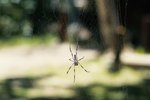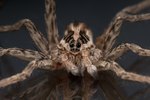
No matter where you are, spiders are among the most common bugs you'll come across. Spiders live inside your home, in your garden and everywhere in between. Spiders may look scary, but most spiders aren't actually venomous to humans. With the exception of the black widow, the most common spiders of Mexico are harmless to humans.
Burrowing Red-Kneed Tarantula
The red-kneed tarantula (Brachypelma smithi) is native to the scrub forests of Mexico. The red-kneed tarantula is a burrower often found in soft dirt under and around large rocks or tree roots. The tarantula is a large species with an leg span of about 5.5 inches. Fine, black hairs cover the tarantula's body, but yellow and orange hairs cover the knee joints, giving the creature his name. The tarantula will eat just about any insect, small invertebrate and even baby birds and rodents. The red-kneed tarantula is harmless to humans, though it may shoot hairs that can cause mild skin irritation.
Jumping Spiders Don't Need Trampolines
About 300 species of jumping spider, the Salticidae family, inhabit North America. A jumping spider may be found in the garden or inside the house. He's a fairly harmless spider who will actually try to avoid human contact, but he will face predators if he's provoked. The jumping spider doesn't typically weave webs but will ambush prey and will jump 10 to 40 times his body length. A jumping spider is easily distinguished from other spiders, as he has two rows of eyes.
The Wolf Family
Wolf spiders are common across the United States and Mexico. The Lycosidae family of wolf spiders includes numerous species that range throughout North America; some species range from Mexico all the way to Canada. Wolf spiders are commonly found within the home along floorboards and in closets. The bite of a wolf spider is relatively harmless; it may cause only a mild discomfort. Generally, these spiders are great to have around, as they tend to feed off the roaches and other bugs that are more of a pest.
Venomous Widows
The black and brown widow spiders are of the Latrodectus genus. The black widow is one of the most venomous spiders in North America; the venom is about 15 times stronger than a rattlesnake's. The brown widow is not as toxic as the black widow, but she can cause a serious reaction, depending on your sensitivity. The most identifying trait of the widow is the red hourglass on the bottom of the adult female widow. A widow will spin a large web to capture her prey; she will eat just various insects that get caught in her web.
Spiders That Build Orb-Shaped Webs
The colonial orb-weaving spider is one of many orb weavers residing in Mexico and throughout the world. Orb-weaving spiders are of the Araneidae family, which contains more than 3,500 species of spiders. An orb-weaving spider will create orb-shaped webs, one within another, to catch their prey. You'll find orb weavers in outdoor corners or building their webs in tall grass, in bushes or on outdoor furnishings.
Venomous Wandering Spiders
The Mexican Cupiennius salei spider is one of many wandering spiders of the Ctenidae family. The Cupiennius genus runs throughout Mexico and much of South America. Many wandering spiders resemble wolf spiders, but this type of spider can be large and venomous, depending on the species. The Cupiennius salei doesn't produce webs but sits and waits for his prey, which may include grasshoppers, moths or butterflies, roaches, frogs and small lizards. The Cupiennius salei is an arboreal species most active at night.
Slinky Lynx Spiders
The green lynx spider is the largest lynx spider in North America and is one of many lynx spiders found in Mexico. He's of the Oxyopidae family, which is a group of lynx spiders known to thrive on plants, flowers and shrubs. The green lynx spider camouflages himself in cacti and other green plants while waiting for prey. The bite of a green lynx is nontoxic to humans, but he rarely bites a human anyway.
References
- Bristol Zoo: Red Kneed Tarantula
- Desert USA: Wolf Spider
- National Geographic: Black Widow Spider
- Bad Spider Bites: Jumping Spider
- Bug Guide: Orb Weavers
- Francesco Tomasinellie; British Tarantula Society Journal: Cupiennius Salei
- Cirrus Image: Green Lynx Spider - Peucetia Viridans
Photo Credits
-
NA/PhotoObjects.net/Getty Images


